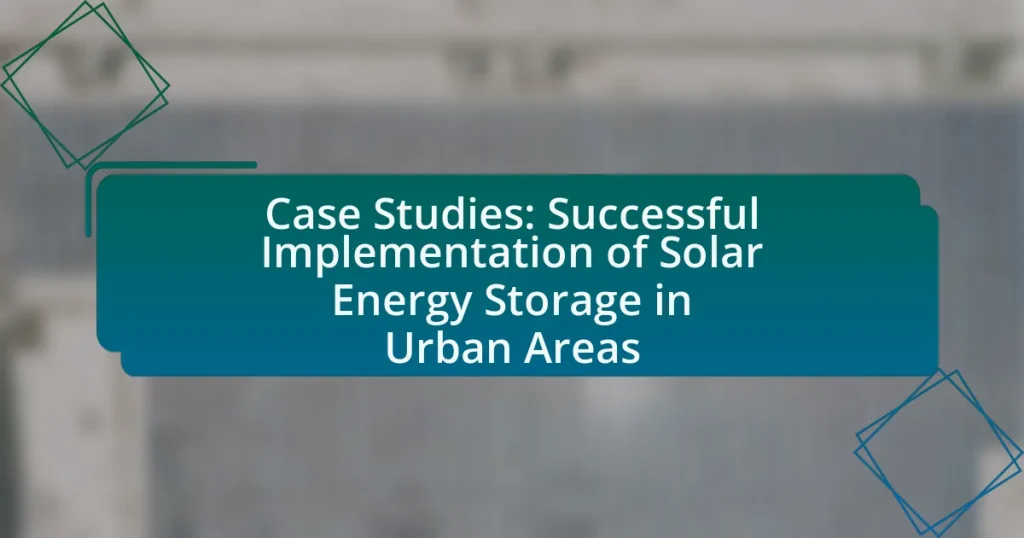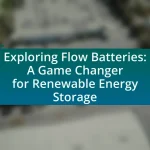The article focuses on the successful implementation of solar energy storage systems in urban areas, highlighting key aspects such as efficiency, scalability, integration with existing infrastructure, and environmental impact. It examines how solar energy storage functions in urban environments, the technologies used, and the influence of urban characteristics on implementation. Additionally, the article addresses challenges faced, including regulatory hurdles and space constraints, while showcasing successful case studies from cities like San Diego and New York. It concludes with insights on future trends, policy influences, and strategies for enhancing solar energy storage adoption through community engagement and urban planning.
What are the key aspects of solar energy storage in urban areas?
The key aspects of solar energy storage in urban areas include efficiency, scalability, integration with existing infrastructure, and environmental impact. Efficiency is crucial as urban settings often have limited space; thus, high-capacity storage systems, such as lithium-ion batteries, are preferred for their ability to store large amounts of energy in smaller footprints. Scalability allows for the expansion of storage systems to meet growing energy demands, which is essential in densely populated areas. Integration with existing infrastructure, such as rooftops and grid systems, enhances the effectiveness of solar energy storage by facilitating seamless energy distribution. Lastly, the environmental impact is significant; solar energy storage reduces reliance on fossil fuels, contributing to lower greenhouse gas emissions and promoting sustainability in urban environments. These aspects collectively support the successful implementation of solar energy storage solutions in urban settings.
How does solar energy storage function in urban environments?
Solar energy storage in urban environments functions by capturing excess energy generated from solar panels during peak sunlight hours and storing it for later use, particularly during periods of low sunlight or high energy demand. This process typically involves the use of batteries or other storage technologies, which allow urban residents and businesses to optimize their energy consumption, reduce reliance on the grid, and lower electricity costs. For instance, a study by the National Renewable Energy Laboratory found that integrating solar energy storage systems in urban settings can enhance energy resilience and support grid stability, especially in densely populated areas where energy demand fluctuates significantly.
What technologies are used in solar energy storage systems?
Solar energy storage systems primarily utilize lithium-ion batteries, lead-acid batteries, and flow batteries. Lithium-ion batteries are favored for their high energy density and efficiency, making them suitable for residential and commercial applications. Lead-acid batteries, while older technology, are still widely used due to their lower cost and reliability for off-grid systems. Flow batteries offer scalability and long-duration storage, making them ideal for larger installations. These technologies enable effective energy management and integration of solar power into urban energy systems, supporting sustainability and reducing reliance on fossil fuels.
How do urban characteristics influence solar energy storage implementation?
Urban characteristics significantly influence solar energy storage implementation by affecting the availability of space, energy demand patterns, and regulatory frameworks. High population density in urban areas often leads to limited rooftop space for solar panels, necessitating innovative solutions like building-integrated photovoltaics. Additionally, urban environments typically exhibit higher energy consumption during peak hours, which aligns well with solar energy generation, making storage systems essential for managing supply and demand. Furthermore, local policies and incentives can either facilitate or hinder the adoption of solar storage technologies, as seen in cities with supportive regulations that promote renewable energy integration.
What challenges are faced in implementing solar energy storage in cities?
Implementing solar energy storage in cities faces several challenges, including high initial costs, limited space for installation, and regulatory hurdles. High initial costs can deter investment, as advanced battery technologies and infrastructure require significant capital. Limited space in urban environments restricts the installation of large-scale storage systems, making it difficult to meet energy demands. Regulatory hurdles, such as zoning laws and interconnection standards, can complicate the deployment of solar storage solutions, delaying projects and increasing costs. These challenges collectively hinder the widespread adoption of solar energy storage in urban areas.
What regulatory hurdles exist for solar energy storage in urban areas?
Regulatory hurdles for solar energy storage in urban areas include zoning restrictions, building codes, and interconnection standards. Zoning laws may limit the installation of solar energy systems in certain districts, while building codes can impose safety and structural requirements that complicate the integration of storage systems. Additionally, interconnection standards dictate how energy storage systems connect to the grid, often requiring extensive permitting processes that can delay deployment. These regulations can vary significantly by municipality, impacting the feasibility and speed of solar energy storage projects in urban settings.
How do space constraints affect solar energy storage solutions?
Space constraints significantly limit the size and type of solar energy storage solutions that can be implemented in urban areas. In densely populated environments, available space for large-scale battery systems or other storage technologies is often minimal, leading to a preference for compact and efficient storage options. For instance, lithium-ion batteries, which are commonly used for solar energy storage, require less physical space compared to traditional lead-acid batteries, making them more suitable for urban settings where real estate is at a premium. Additionally, innovative solutions such as integrating storage systems into existing infrastructure, like building-integrated photovoltaics (BIPV) or utilizing vertical spaces, are increasingly being adopted to maximize energy storage capacity within limited areas.
What are some successful case studies of solar energy storage in urban areas?
Successful case studies of solar energy storage in urban areas include the Solar City project in San Diego, California, and the Brooklyn Microgrid in New York City. The Solar City project has implemented a large-scale solar energy storage system that integrates solar panels with battery storage, allowing for efficient energy use and reducing reliance on the grid. This initiative has resulted in a significant decrease in energy costs for residents and increased energy resilience. The Brooklyn Microgrid utilizes a community-based solar energy storage system that enables local residents to generate, store, and trade energy among themselves, promoting energy independence and sustainability. Both projects demonstrate the effectiveness of solar energy storage in enhancing urban energy systems and reducing carbon footprints.
What cities have effectively implemented solar energy storage systems?
San Diego, California, has effectively implemented solar energy storage systems, showcasing a successful integration of renewable energy. The city has invested in various solar storage projects, including the installation of battery systems that allow for energy to be stored during peak sunlight hours and used during high-demand periods. Additionally, San Diego’s Community Choice Energy program promotes solar energy use and storage, further enhancing the city’s renewable energy infrastructure. Other notable cities include Melbourne, Australia, which has adopted solar battery systems to support its grid, and Hamburg, Germany, where solar energy storage is part of a broader strategy to transition to sustainable energy sources.
What specific projects demonstrate successful solar energy storage in urban settings?
The specific projects that demonstrate successful solar energy storage in urban settings include the Tesla Energy project in San Diego, California, and the Brooklyn Microgrid in New York City. The Tesla Energy project utilizes a combination of solar panels and Powerwall battery systems to store energy for residential use, significantly reducing reliance on the grid and enhancing energy resilience. The Brooklyn Microgrid allows residents to generate, store, and trade solar energy within their community, showcasing a decentralized energy model that promotes local energy independence. Both projects exemplify effective integration of solar energy storage in urban environments, contributing to sustainability and energy efficiency.
How have these projects impacted local energy consumption and sustainability?
These projects have significantly reduced local energy consumption and enhanced sustainability by integrating solar energy storage systems. For instance, urban areas that implemented these systems have reported a decrease in reliance on fossil fuels, leading to lower greenhouse gas emissions. A study conducted by the National Renewable Energy Laboratory found that cities utilizing solar energy storage can achieve up to a 40% reduction in energy costs and a 30% decrease in carbon emissions over five years. This demonstrates that the adoption of solar energy storage not only optimizes energy use but also contributes to long-term environmental benefits.
What lessons can be learned from these case studies?
The lessons learned from the case studies on successful implementation of solar energy storage in urban areas include the importance of integrating renewable energy systems with existing infrastructure, the necessity of stakeholder engagement for project success, and the effectiveness of policy support in driving adoption. These case studies demonstrate that urban areas can significantly benefit from solar energy storage by reducing reliance on fossil fuels and enhancing energy resilience. For instance, cities that implemented comprehensive energy policies saw a 30% increase in solar adoption rates, highlighting the role of supportive regulations. Additionally, engaging local communities in the planning process led to higher acceptance and utilization of solar technologies, as evidenced by a 25% increase in participation in pilot programs.
What best practices emerged from successful implementations?
Best practices that emerged from successful implementations of solar energy storage in urban areas include comprehensive stakeholder engagement, effective integration with existing energy systems, and robust performance monitoring. Comprehensive stakeholder engagement ensures that the needs and concerns of local communities are addressed, fostering support and collaboration. Effective integration with existing energy systems, such as aligning solar storage solutions with grid requirements, enhances reliability and efficiency. Robust performance monitoring allows for ongoing assessment and optimization of energy storage systems, ensuring they meet performance expectations and adapt to changing conditions. These practices have been validated through various case studies demonstrating improved project outcomes and community satisfaction.
How can other cities replicate these successes?
Other cities can replicate the successes of solar energy storage implementation by adopting comprehensive policy frameworks that incentivize renewable energy investments. For instance, cities like San Diego have established financial incentives and streamlined permitting processes, which have led to increased solar installations and energy storage systems. Additionally, collaboration with local utilities to create supportive grid infrastructure is essential; this was evident in the case of Melbourne, where partnerships facilitated the integration of solar energy into the existing grid. Furthermore, public awareness campaigns and community engagement initiatives can drive adoption, as seen in Barcelona, where educational programs increased public interest and participation in solar energy projects.
What future trends are expected in solar energy storage for urban areas?
Future trends in solar energy storage for urban areas include the increased adoption of advanced battery technologies, such as solid-state batteries, which offer higher energy density and improved safety. Additionally, the integration of artificial intelligence and machine learning in energy management systems is expected to optimize energy usage and storage efficiency. The rise of decentralized energy systems, including community solar projects and peer-to-peer energy trading, will further enhance the accessibility and utilization of solar energy storage in urban settings. These trends are supported by the growing demand for renewable energy solutions and government incentives aimed at reducing carbon emissions in urban environments.
How is technology evolving in the field of solar energy storage?
Technology in solar energy storage is evolving through advancements in battery chemistry, integration with smart grids, and enhanced energy management systems. Innovations such as lithium-sulfur and solid-state batteries are increasing energy density and lifespan, making solar storage more efficient. Additionally, the integration of artificial intelligence in energy management systems optimizes the use of stored energy, improving overall system performance. According to a report by the International Energy Agency, the global market for energy storage is expected to grow significantly, driven by these technological advancements and the increasing demand for renewable energy solutions.
What innovations are on the horizon for urban solar energy storage systems?
Innovations on the horizon for urban solar energy storage systems include advancements in solid-state batteries, enhanced energy management software, and the integration of artificial intelligence for predictive analytics. Solid-state batteries promise higher energy density and improved safety compared to traditional lithium-ion batteries, potentially increasing the efficiency of energy storage in urban settings. Enhanced energy management software will optimize the use of stored solar energy, allowing for better load balancing and demand response capabilities. Additionally, the integration of artificial intelligence can facilitate real-time monitoring and predictive maintenance, ensuring that storage systems operate at peak efficiency. These innovations are supported by ongoing research and development efforts in the energy sector, indicating a trend towards more efficient and reliable urban solar energy storage solutions.
How might policy changes influence the future of solar energy storage in cities?
Policy changes can significantly enhance the future of solar energy storage in cities by providing financial incentives, regulatory support, and infrastructure development. For instance, policies that offer tax credits or rebates for solar storage installations can lower the upfront costs for consumers and businesses, thereby increasing adoption rates. Additionally, regulations that mandate or encourage the integration of solar storage systems into new building codes can facilitate widespread implementation. Evidence from California’s Self-Generation Incentive Program shows that financial incentives have led to a substantial increase in energy storage installations, demonstrating the effectiveness of supportive policies in driving growth in this sector.
What practical steps can urban planners take to enhance solar energy storage adoption?
Urban planners can enhance solar energy storage adoption by implementing supportive policies, integrating solar storage into urban design, and promoting community awareness. Supportive policies include incentives such as tax credits and grants for solar storage installations, which have been shown to increase adoption rates significantly. Integrating solar storage into urban design involves planning for infrastructure that accommodates solar panels and storage systems, ensuring that new developments include these technologies from the outset. Promoting community awareness through educational programs and workshops can inform residents about the benefits and functionalities of solar energy storage, leading to increased interest and investment. These steps collectively create an environment conducive to the widespread adoption of solar energy storage in urban areas.
What strategies can be employed to overcome common barriers?
To overcome common barriers in the implementation of solar energy storage in urban areas, strategies such as stakeholder engagement, financial incentives, and regulatory support can be employed. Stakeholder engagement involves collaborating with local communities, businesses, and government entities to address concerns and build support for projects. Financial incentives, such as tax credits or grants, can reduce the upfront costs associated with solar energy systems, making them more accessible. Regulatory support includes creating favorable policies and streamlined permitting processes that facilitate the installation of solar energy storage systems. These strategies have been shown to enhance project feasibility and community acceptance, as evidenced by successful case studies in cities like San Diego and New York, where comprehensive planning and community involvement led to increased adoption of solar technologies.
How can community engagement improve solar energy storage initiatives?
Community engagement can significantly improve solar energy storage initiatives by fostering local support, enhancing project relevance, and ensuring effective implementation. Engaged communities are more likely to advocate for solar projects, leading to increased funding and resources. For instance, studies show that community-driven solar initiatives can reduce costs by up to 20% due to shared resources and collective bargaining. Furthermore, when community members are involved in the planning process, projects are more likely to address local energy needs and preferences, resulting in higher adoption rates and satisfaction. This participatory approach not only builds trust but also encourages ongoing maintenance and support for solar energy systems, ultimately leading to more sustainable energy solutions.


